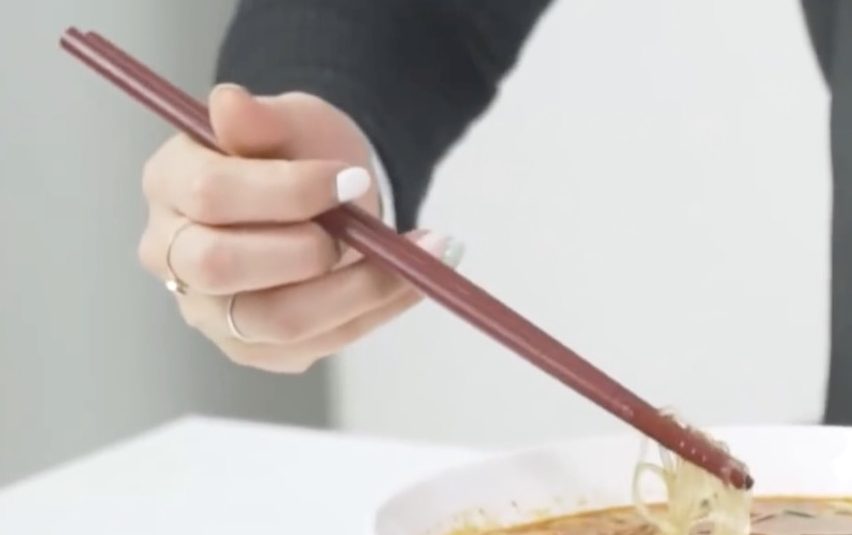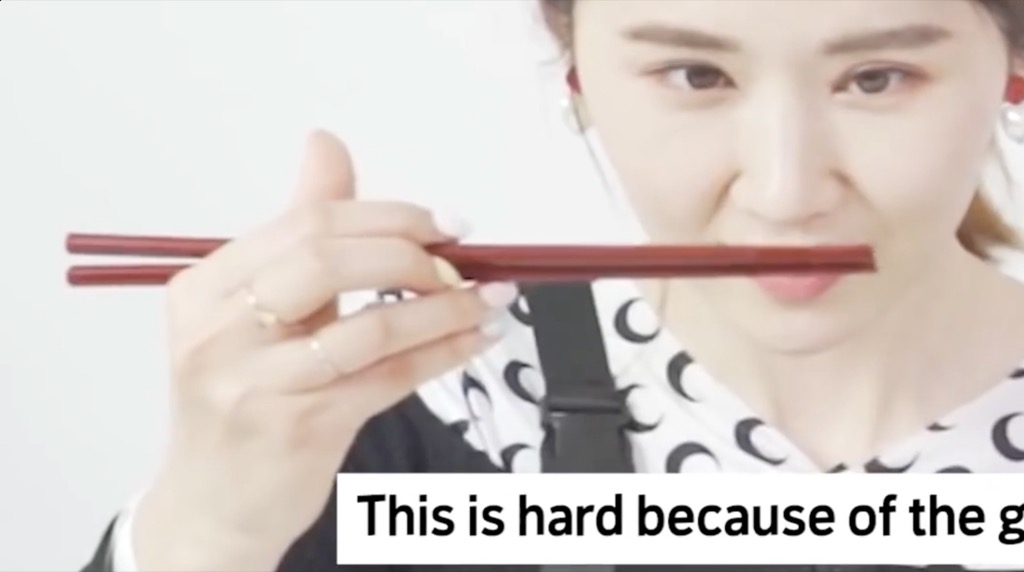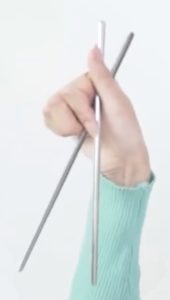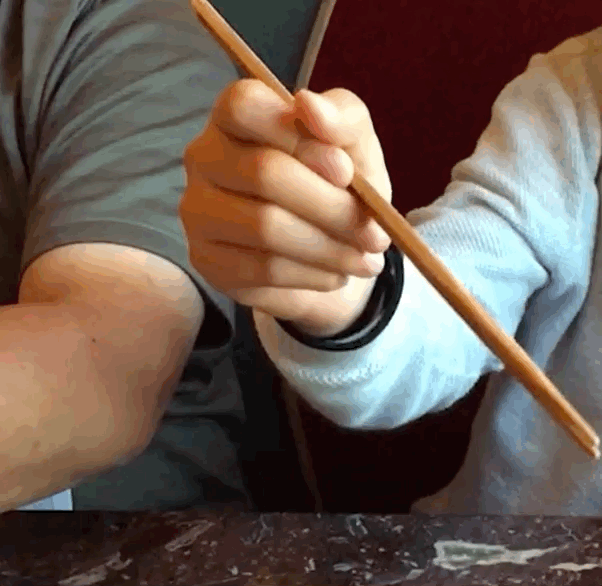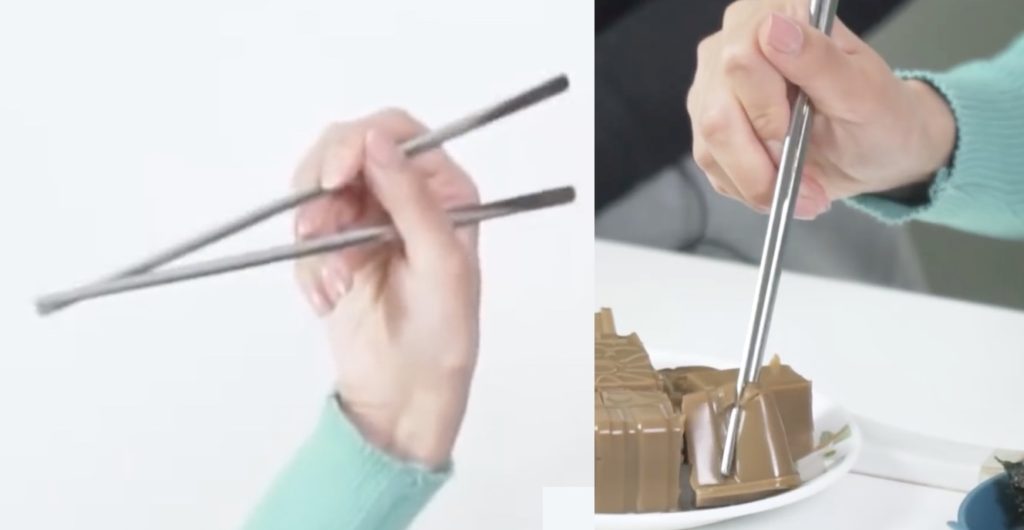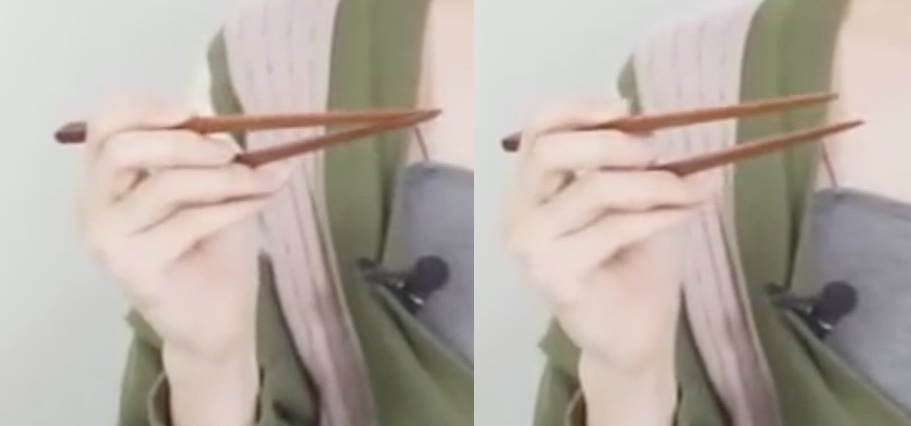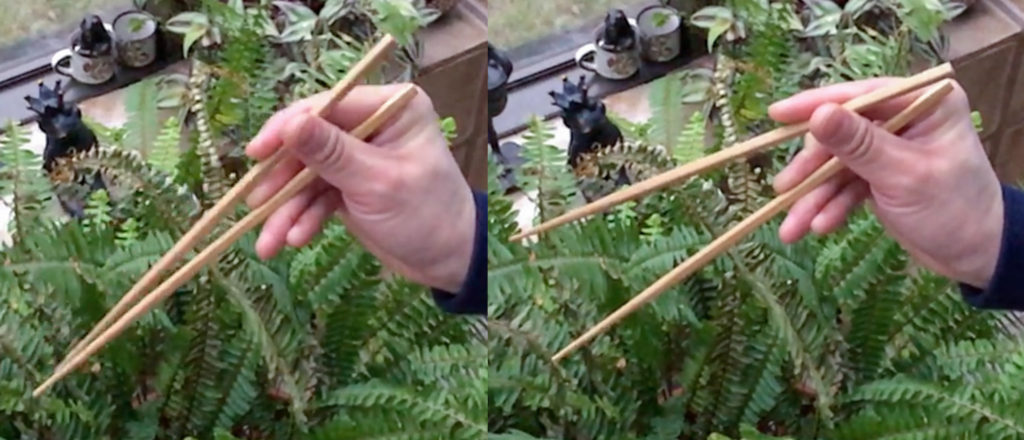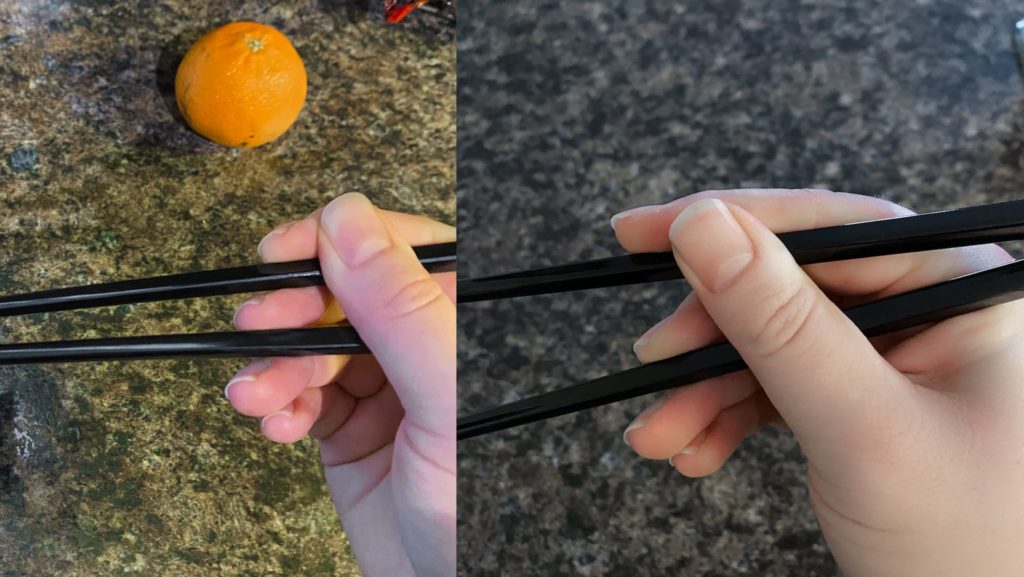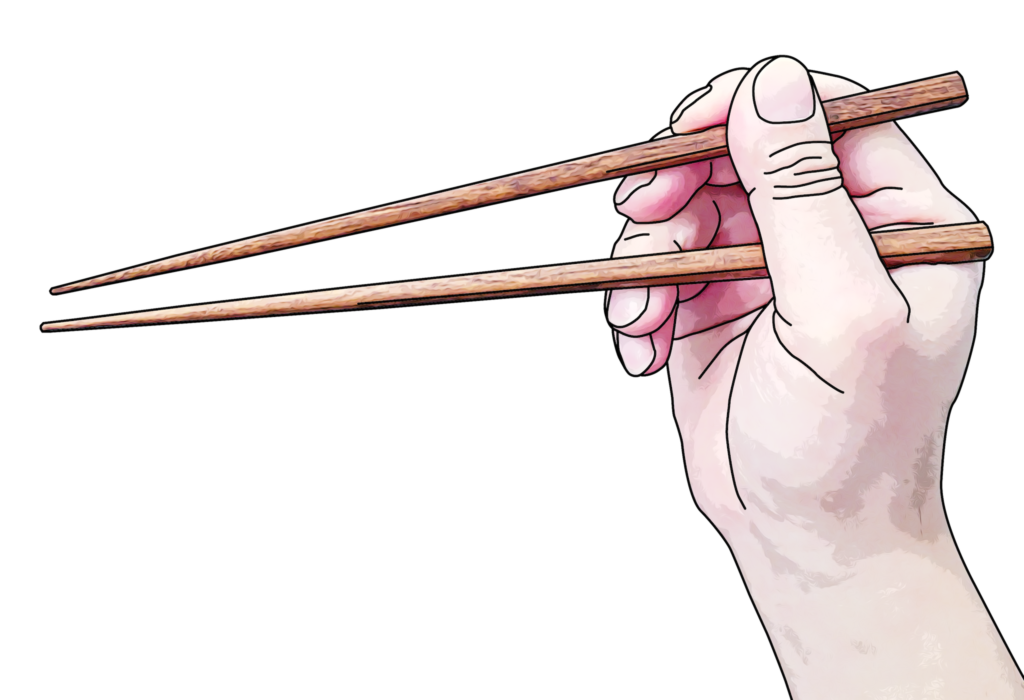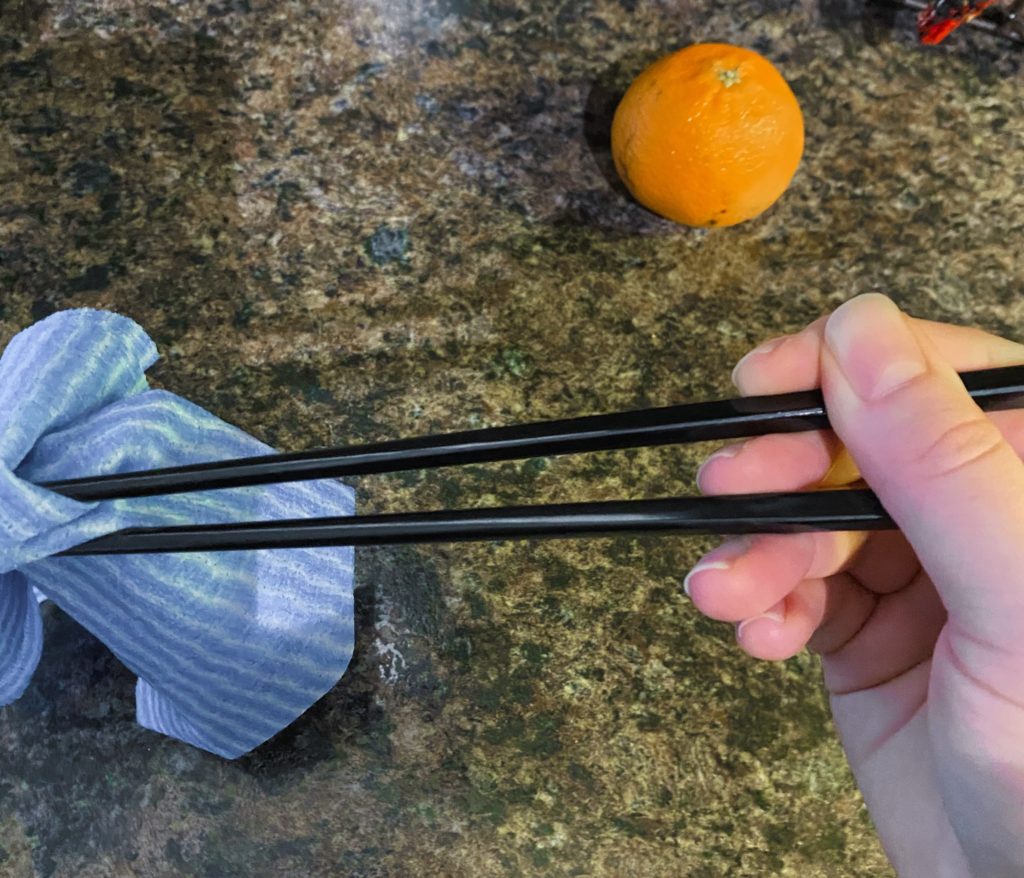Last Updated on 2021 年 10 月 29 日 by 編輯
This is our first article on chopsticking in popular culture. We’ve been itching to write about this topic for some time. But the effort had to wait until we analyzed and published enough chopstick grips. Now that we have some 26 chopstick grips under our belt, at the time of this writing, we can finally start to examine chopsticking scenes from movies, TVs, and YouTube videos. At last, we have words to describe the variety of chopsticking experiences.
Coincidentally, the World Friends channel on YouTube just published an excellent episode on different types of chopsticks: Korean, Chinese and Japanese. This is one of the best videos on chopstick types demonstrated by native users. While the main focus of this episode was on types of chopsticks, the three hostesses demonstrated their own different ways of wielding chopsticks, and discussed how and why they used chopsticks in these ways. We applaud their attitude of inclusion. You can see the full episode on YouTube.
(Updated 2021-10-29. We continue to find gold in World Friends episodes. Just five months after the above episode, they came out with a cup noddle update. This video provides even more footage show how the same three hostesses use chopsticks. Here it is.)
內容目錄
Our hostesses
From left to right, we have Jane, Hyejin, and Kotoha, as our hostesses. They showed how Chinese, Korean, and Japanese folks use chopsticks, respectively.
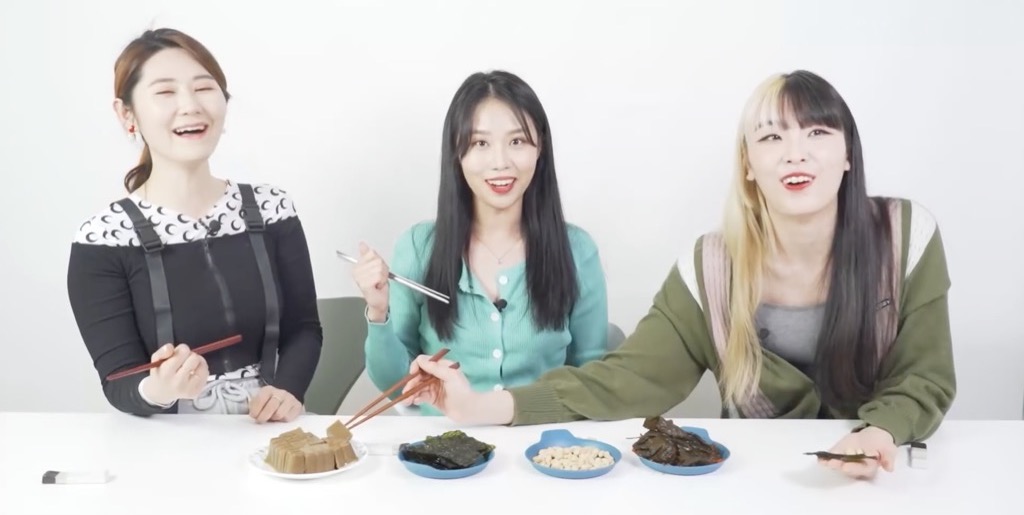
Jane – Double Hook grip
Jane uses Chinese chopsticks in her daily life. They are long and without tapered tips. But in this recording, she was given shorter chopsticks with tapered tips. These didn’t work very well for her when picking up some food items. At times she reversed chopsticks, so she could use blunt rear ends, instead of tapered tips, to pick up food in ways she was accustomed to. We slowed down the video a bit to show intricate finger movements.
Following images show the Closed posture (left) and the Open posture (right) from one part of the video.
We haven’t seen anyone use chopsticks in exactly the same way she does, at the writing of this article in May 2021. But we do have the vocabulary that can be used to describe how she wields chopsticks. In short, her chopstick grip adopts one type of mechanism for pinching food between chopstick tips, and a different type of mechanism for extending tips of chopsticks apart to embrace food. More specifically, she uses a compression finger movement from the Lateral chopstick family, and an extension finger movements from the Idling Thumb grip. As we will explain shortly, this is very similar to how Chicken Claws adopts a Lateral compression, and an Idling Thumb-like extension.
Her Compression posture is almost identical to the Compression posture of all Lateral chopstick grips. In the comparison shown below, we chose a particular Lateral variant for its similar viewpoint. There is one subtle difference, however. Jane leaves her ring finger to support both chopsticks, while the middle finger barely touches the bottom chopstick. But in Jane’s case, she user the knuckle of her middle finger to push the top chopstick down.
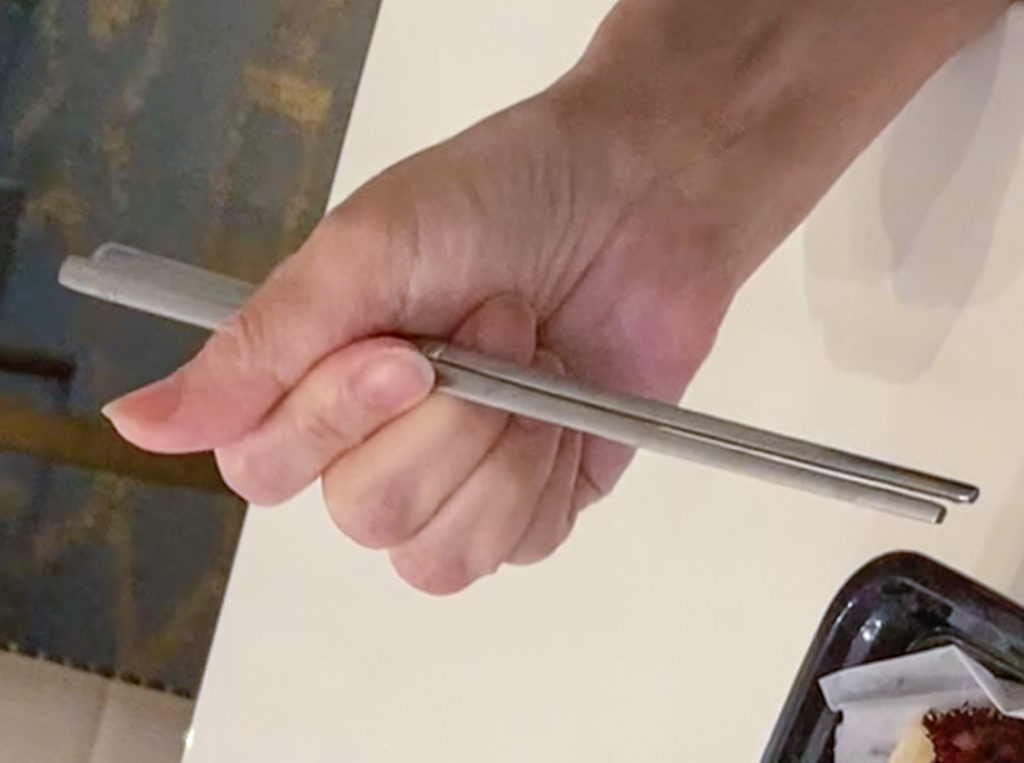
The way Jane extends chopsticks open is similar to that of Idling Thumb. The top chopstick is caged mainly by the index finger and the middle finger. The thumb pad only serve as a guardrail, without applying much force on the top chopstick. The base of the thumb and the ringer finger work together to hold the bottom chopstick in place. Unlike Idling Thumb, however, Jane mainly moves the bottom chopstick, instead of the top chopstick. This is accomplished by the thumb pad moving from its Compression pose, to the Open posture pose, while the thumb base nudges the bottom chopstick open.
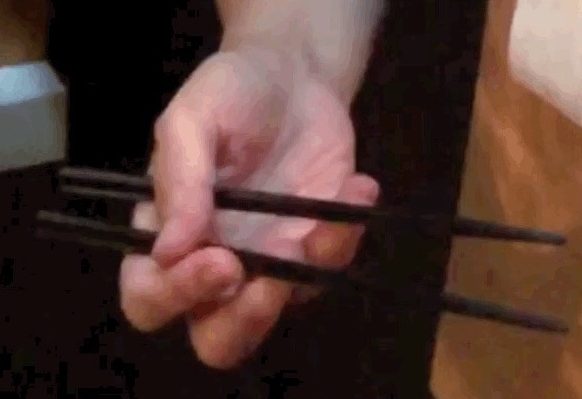
The abandonment of the thumb pad at the Compression posture, and the reengagement of the thumb pad at the Open posture is reminiscent of Chicken Claws.
(updated 2021-08-11) At the writing of this article, we referred to her grip as “Lateral compression with Idling Thumb extension”. By August 2021, we found another grip used by Chaeyoung from TWICE that is a close variant of Jane’s grip. We named Chaeyoung’s grip “Hook n Clamp“. And by analogy we then named Jane’s grip “Double Hook”.
As we explained in Lateral Classic grips, practitioners wielding a Lateral compression posture usually tilt chopsticks right after they pick up food, to gain a better leverage. Jane is no exception, as shown below.
Jane mentioned several times in the video about how tapered chopstick tips was detrimental to gripping power. This also has to do with the fact that lateral grips have rear ends of chopsticks abutting each other at the Compression posture. As Jane mentioned, this leaves a wide gap between chopstick tips. Using Chinese-style chopsticks with blunt tips would help practitioners of Lateral-style grips pick up thin pieces of food such as seaweed, or slippery food such as glass noodles.
Jane – transition to Cupped Vulcan
At times Jane moves her ring finger out, to assist in extending the bottom chopstick away fro the top chopstick. This is illustrated below. On the far left, the bottom chopstick sits on the knuckle of the ring finger. As we move to the right, the ringer finger is seen moving out. The tip of the ring finger ends up pushing the bottom chopstick outward. This movement is coupled with the hand tilting chopsticks downward.

Pointing chopstick tips down allows gravity to assist in prying the two chopsticks apart. This works, because the index finger and the middle finger holds the top chopstick immobile with respect to the movement of the hand. Jane then reduces thumb pressure on the bottom chopstick, allowing it to swing away from the top chopstick by gravity. The use of the ring finger to nudge the bottom chopstick, and the leverage from gravity assist is reminiscent of Cupped Vulcan, even if above images do not look quite like Cupped Vulcan.
In a few instance, Jane does make the full transition to Cupped Vulcan. Compare following images to see this transition. Jane uses Cupped Vulcan at times to extend chopsticks apart.
Regardless of how chopstick tips are extended apart, Idling Thumb-fashion or Cupped Vulcan-fashion, the closing of chopstick tips always follows the way of Lateral grips, for Jane. Following images illustrate this compression movement.

Compare the above sequence to the Lateral Chick video shown below.
Hyejin – Scissorhand grip
Hyejin primarily wields the Scissorhand grip. While many regard it as weird and unusual, it really isn’t. This grip is close to several grips that most practitioners would deem ordinary, such as Idling Thumb, Chicken Claws, and Lateral Chick. Many people are put off by the fact that chopsticks look crossed. But we’ve dispelled such misconception in Out with the Crossed Type, in with the Under Swing already. We won’t repeat it here. Since writing that “underswing” article based on Scissorhand, we’ve identified more sideway swing and underswing grips, such as Lateral Money and Lateral Thumb Wrestler. See Ten thousand ways to use chopsticks for additional examples.
Compare her perfect Scissorhand posture to our type specimen picture. Ignore the tip segment of the thumb. It is unused. So it may be curled or extended flat, without affecting chopstick operations.
Following are various perspectives of her Scissorhand grip, at the Open posture.
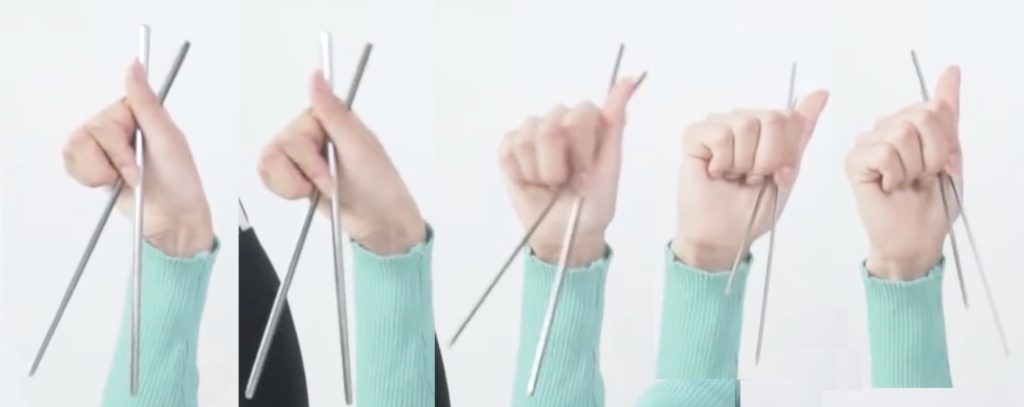
Following videos show that Hyejin’s finger movements are identical to what we have previously recorded from a Scissorhand practitioner. This is what we call an underswing movement (for the top chopstick).
Hyejin – Standard Grip for snapping air
As Hyejin verbalized and demonstrated, she too is able to wield Standard Grip. This is illustrated below.
We find similar stories from practitioners we survey. Many practitioners of alternative grips know and can demonstrate finger movements from Standard Grip. But most find it unnatural to use in real life, or simply find the grip they grew up with more comforting. Some of these anatomical issues are documented in Caswellian thumb and chopsticks.
It is time we embrace alternative grips. We can and should celebrate practitioners who master more than one grip. In fact, all three hostesses in this episode wield more than one grip type. See Hyejin’s Closed posture (Standard Grip) below left, versus her Compression posture (Scissorhand) below right.
Starting with Cupped Vulcan, we realized that practitioners often use different finger movements for closing tips of chopsticks without a payload (e.g. snapping air). We call the end state of this air-snapping the Closed posture. What we started doing recently is to designate a separate Compression posture (with and against a payload), for grips where different finger movements are deployed to firmly pinch food between chopsticks.
Hyejin – Lateral Thumb Wrestler
Continuing our theme of practitioners being multi-grip talented, we have a sequence of Hyejin picking up noodles shown below. The left most image clearly shows that she did not use Scissorhand for extending chopsticks apart in this instance. It is clear that the top chopstick swings in a classic way, not with an underswing.

It is tempting to theorize that she used another classic-swing variant of Lateral chopstick grips in picking up noodles. For instance, the left most image above does resemble a particular moment of Lateral Squid.
However, we have now gathered enough video footage of practitioners improvising grips under different situations, that we can confidently say that she simply found that for picking up noodles, one merely need to stick the two chopstick into the soup, and wiggle. Usually one can prod chopstick tips open against food that way. It doesn’t matter which “grip” was used to extend chopsticks apart. It only matters that one find a way to pinch slippery noodles firmly, once chopsticks have been nudged into expected positions. In this instance, she used the Lateral Compression posture for pinching food.
Note how she twisted her wrist in the process, to tilt noodles up. We have briefly discussed such wrist-twisting and chopstick-tilting earlier. This noodling-lifting movement is yet another example of the same. Following are videos from the Lateral classic grips article showing the same chopstick tilting.
It is possible that Hyejin wields many Lateral classic grips. But we don’t have enough video evidence of those. What we do have from the episode are images that clearly illustrate her use of the Lateral Thumb Wrestler grip. This is an underswing variant of Lateral Classic.

Compare her images to what we have recorded for Lateral Thumb Wrestler below. Clearly, every practitioner lends his or her unique touch to this grip. No two renditions are completely identical. But they do share common thumb-wrestling features.


Kotoha – Standard Grip for snapping air
Kotoha primarily uses Standard Grip for extending chopsticks apart, and in closing chopstick tips without payload (e.g. snapping air). She switches to Turncoat for pinching food, when applying compression pressure. Following slow-motion digest summarizes her chopsticking demonstrations from the episode.
Following images demonstrate the Closed posture and the Open posture of her Standard Grip.
Kotoha – Turncoat for pinching food
As mentioned earlier, carrying or not carrying a payload often alters how a practitioner wields chopsticks. A relaxed open posture is shown below left. A compression posture with noodles pinched between tips of chopsticks is shown below right. At a glance, these two images appear to illustrate the Standard Grip.

Following is a sequence of images showing Kotoha picking up noodles. They may still look like Standard Grip. But when one examines the middle finger more closely, one notices that this is indeed the Turncoat grip where the middle finger switches allegiance from the top chopstick to the bottom chopstick.
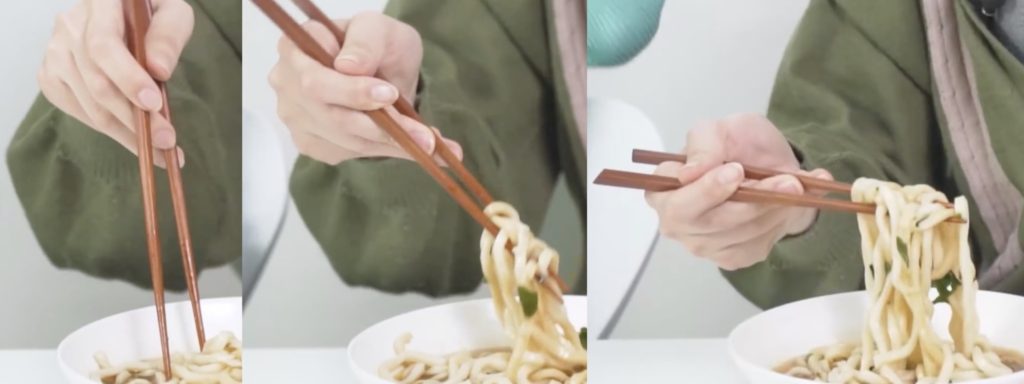
Following show the Closed posture and the Open posture, again without a payload. But this time they are shown from a more common perspective used on marcosticks.org. This allows us to compare them to other pictures from our past studies.
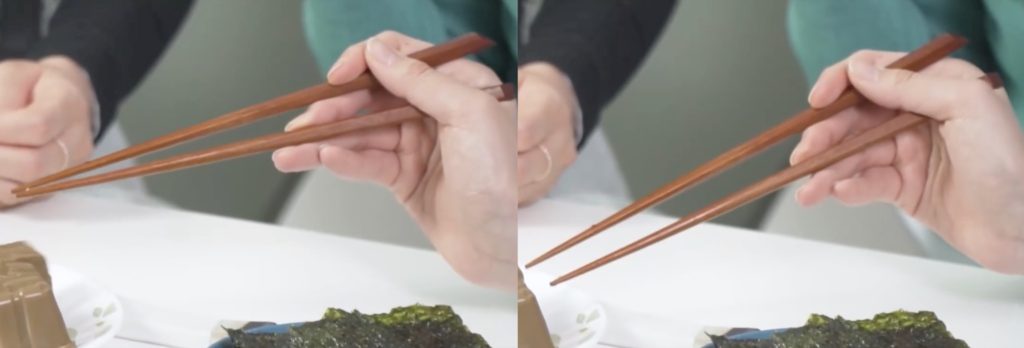
Look her pictures from above, to Turncoat pictures below.
Turncoat does look like Standard Grip. Most people can’t tell them apart at a glance. They are more differentiated at the Open posture. The image found below left shows the Max open posture of Standard Grip. The image below right shows the Open posture of Turncoat. The main difference between them is, of course, location of the middle finger.
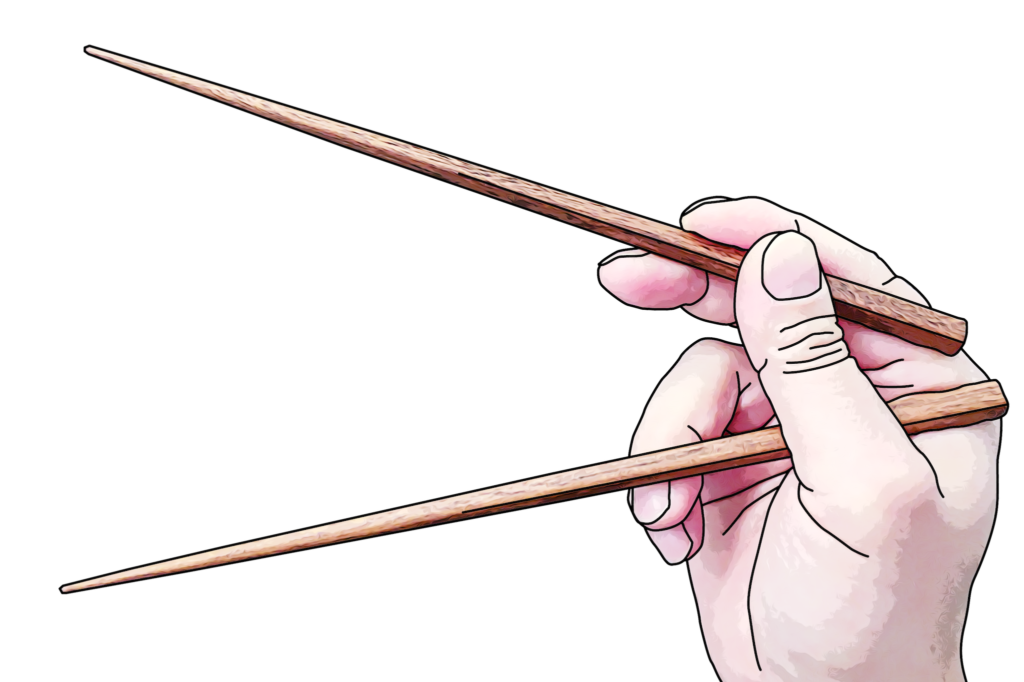

However, at the Closed posture, the boundary between these two grips is blurrier. The two pictures below look very similar. If the two chopsticks on the left (Standard Grip) were not separated far enough at the rear end, then the middle finger would touch both top chopstick and bottom chopstick, as is the case with Turncoat on the right.
We find more and more practitioners who alternate between Standard Grip and Turncoat. This writer himself only realized recently, that this fact applied to himself, too. Following images of Kotoha picking up jello more clearly show her Turncoat Compression posture in action.

The jello-lifting competition
Near the end of the episode there was an amicable competition to see who could pick up jello without breaking them. It was stated in this segment, as well as earlier in the episode, that blunt chopstick tips worked better. In fact, Jane managed to pick up a piece of jello intact, with blunt ends of chopsticks. Blunt ends provide larger surface areas for gripping, enabling lighter compression forces from chopsticks to lift jello without slicing into them.
But there are additional factors at play here. The first is illustrated below. Note how Jane surrounds the jello with chopsticks pointing vertically down, at first. Then she gently nudges the piece of jello detached from the plate and its jello siblings. She accomplishes the feat by twisting her wrist, and thus tilting chopsticks slightly upward. This sequence of movements allows the two chopsticks to settle into said food item’s irregular and malleable surface, as the food item is wiggled in the process. This is a common technique among Lateral grip practitioners, and we documented it here.

Yet another factor has to do with braking power. This is a topic we have not elaborated elsewhere on marcosticks.org. We only hinted at it in The Art and Science of Chopsticking:
We also emphasize extension power and chopstick reach. Because finesse comes as a balance of compression vs extension power. And precision is ironically a result of being able to command an expansive chopstick reach.
In order to pick up flimsy and pliable stuff like jello, a practitioner must apply enough force to firmly grasp it, but not too much as to break into it. Throughout the lifting process, fingers need to feel the texture of the food item via counterforces coming back from food surface. The practitioner must increase compression forces exerted by chopstick tips, or reduce them, at a blink of an eye as needed.
The trouble with the Compression postures of many chopstick grips, such as Lateral grips, is that they are only good at applying more and more compression forces by clutching fingers together. But they are not good at extending chopsticks apart. They are like a bikes without brakes. They can keep going faster and faster. But they can’t brake to reduce speed.
Jane is able to pick up jello, partially because she was wielding Idling Thumb. With this grip, the index finger and the middle finger cages the top chopstick firmly. These two fingers act like a brake. They are able to reduce compression forces on jello by slightly extending the top chopstick away. With this balance of compression vs extension power, she was able to applied just the right amount of force.
Conclusions
Every time we look at yet another footages of practitioners, we discover more ways people wield two simple sticks. We also confirm some ideas that have been fermenting for a while.
For instance, in doing this analysis of the World Friends episode, we found that almost no one wielded a single chopstick grip exclusively. All three hostesses in this episode switched between different but related grips as situations called for. If we were lead to believe otherwise in the past, it was because we rarely had long video footage of any surveyed practitioner picking up different food items under different conditions. We often had limited time, and took only a few snapshots of a practitioner doing only one single movement.
Jane extends chopsticks apart with Idling Thumb, but closes them against food items with Lateral compression. Sometimes she adopts Cupped Vulcan for extending chopsticks apart.
Hyejin believes that she primarily uses Scissorhand. But actual observations show that she switches to Lateral Thumb Wrestler as often as she uses Scissorhand. These two grips differ only in how they extend chopsticks apart. Both grips clutch chopsticks closed with the same Compression posture.
Kotoha, like this writer himself, believes that she only uses Standard Grip. But the reality is that Standard Grip and Turncoat share very similar Closed and Compression postures, when the rear ends of chopsticks are not separated far enough. Many practitioners, including Kotoha and this writer himself, subconsciously switch between these two grips, as situations call for.
It seems like all three hostesses know how to demonstrate finger movements of Standard Grip, when only snapping air, and not trying to pick up actual payload. Hyejin demonstrated this in the episode. We believe Jane can as well. Many practitioners of alternative grips that we surveyed also demonstrated the same, but told us they felt uncomfortable and inefficient using Standard Grip.
Oh well. That’s it for now. Happy chopsticking, and check back for the next article on “chopsticking in popular culture”.

